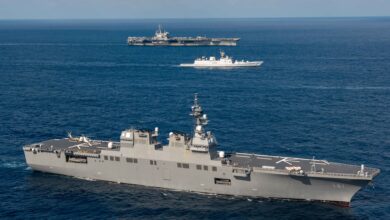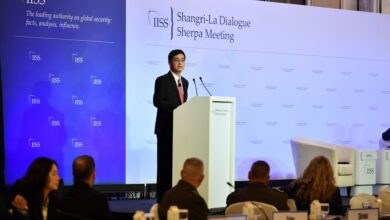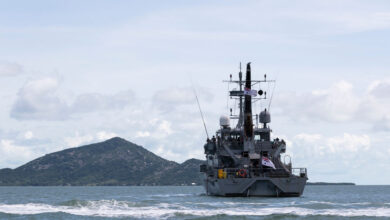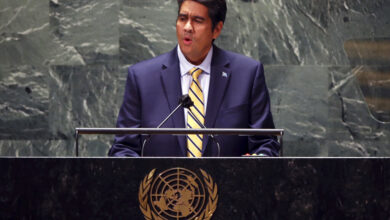U.S. Strategic Command tests all legs of nuclear triad

Top Stories | Feb 24, 2020:
FORUM Staff
U.S. Strategic Command (USSTRATCOM) showcased its ability to conduct coordinated worldwide operations, reassure partners and allies, and accomplish its primary mission of global strategic deterrence with the conclusion of a series of operational events and tests of the nuclear triad.
USSTRATCOM coordinated the event with combatant commands and components across multiple geographic areas to exercise each leg of the nuclear triad — long-range bombers, intercontinental ballistic missiles (ICBMs) and submarine-launched ballistic missiles (SLBMs).
“Our nuclear deterrent underwrites every U.S. military operation around the world and is the backstop and foundation of our national defense,” said Adm. Charles Richard, USSTRATCOM commander. “These tests and operations validate the reliability, accuracy and performance of the nuclear triad and ensure I can provide the president with a range of flexible deterrent options.”
The coordinated events were conducted February 3-12, 2020, and included a Bomber Task Force (BTF) flight of B-52 Stratofortress long-range bombers and test launches of an unarmed ICBM and SLBM. (Pictured: An unarmed Minuteman III intercontinental ballistic missile launches during a developmental test on February 5, 2020, at Vandenberg Air Force Base, California.)
“Nearly 150,000 men and women of the USSTRATCOM nuclear enterprise maintain and operate America’s strategic systems, and they stand ready to respond at a moment’s notice, 24 hours a day, seven days a week, 365 days a year,” Richard said. “Their execution of these events showcased their unwavering professionalism and enduring readiness.”
U.S. forces conducted portions of the event with Japan Self-Defense Forces. Their combined efforts highlight the importance of critical alliances and continued cooperation that underpin the security and stability of the Indo-Pacific region.
AIR: BOMBER MISSION
A U.S. Air Force B-52H Stratofortress bomber from Minot Air Force Base, North Dakota, rendezvoused with a B-52H from Andersen Air Force Base, Guam, on February 3, in the vicinity of Misawa Air Base, Japan, as part of a combined BTF and Continuous Bomber Presence mission.
The bombers also conducted bilateral joint training with 13 Japan Air Self-Defense Force F-2s, four F-4s, 28 F-15s and six U.S. Air Force F-16s in the vicinity of Japan before returning to Andersen.
USSTRATCOM has conducted regular BTF missions since 2014 to integrate and synchronize with the geographic combatant commands’ operations and capabilities and to demonstrate the U.S. commitment to deterrence, assurance and collective security. Strategic bomber missions enhance the readiness and training necessary to respond to any potential crisis or challenge across the globe.
LAND: ICBM TEST
Air Force Global Strike Command Airmen from the 341st Missile Wing at Malmstrom Air Force Base, Montana, the 90th Missile Wing at F.E. Warren Air Force Base, Wyoming, and the 91st Missile Wing at Minot Air Force Base, North Dakota, launched an unarmed Minuteman III ICBM equipped with a test reentry vehicle on February 5 from Vandenberg Air Force Base, California.
The ICBM’s reentry vehicle traveled about 6,750 kilometers to the Kwajalein Atoll in the Marshall Islands. The developmental test launch used a spare missile from storage to validate flight worthiness of new or replacement components in an environment that was as close to operational as possible.
The ICBM test launch program demonstrates the operational capability of the Minuteman III and the readiness of the crews responsible for their operation. These tests validate the United States’ ability to maintain a strong, credible nuclear deterrent as a key element of U.S. national security and the security of U.S. allies and partners.
SEA: SUBMARINE BALLISTIC MISSILE TEST
The U.S. Navy conducted a test flight of a single unarmed life-extended Trident II missile from the USS Maine, an Ohio-class ballistic missile submarine, on the Western Test Range, off the coast of San Diego, California, on February 12.
The test was part of a demonstration and shakedown operation, designated DAS0-30. The primary objective of a DASO is to evaluate and demonstrate the readiness of the submarine’s strategic weapon system and crew before operational deployment following the submarine’s engineered refueling overhaul.
The sea-based leg makes up the majority (about 70%) of the U.S.’ deployed strategic nuclear deterrent triad. The SLBM is the most survivable leg of the triad, provides a persistent presence and allows for flexible concepts of operations.
In addition to testing the USSTRATCOM staff’s ability to coordinate and execute synchronized operations across several combatant commands and geographic theaters, the triad demonstration validated operational capability of USSTRATCOM’s newest weapon system, the Gen. Curtis E. Lemay Command and Control Facility (C2F). The 916,000-square-foot facility, which became operational in January 2020, supports the long-term viability and credibility of the nation’s strategic deterrent force. The C2F is the heart of the nation’s nuclear command and represents the first step in modernizing USSTRATCOM’s nuclear enterprise.
On a recent visit to the C2F, U.S. Secretary of Defense Mark Esper stressed the importance of the USSTRATCOM mission.
“Our top priority is making sure we have a safe, secure, effective and credible strategic deterrent,” Esper said. “That means all legs of the triad, nuclear command, control and communications, and a very effective command under the leadership of a very effective commander.”
Recurring nuclear enterprise tests and enterprise modernization efforts, such as the C2F, demonstrate the global reach of the U.S. strategic enterprise, aim to reassure U.S. allies and partners, and serve to remind adversaries of the U.S. commitment to preserving peace around the world.
“Strategic deterrence is an active mission, and we conduct operations every day to ensure a safe, secure and effective deterrent,” Richard said. “These operations demonstrated that our global warfighting force is ready and able to respond decisively to threats around the world, should deterrence fail.”




